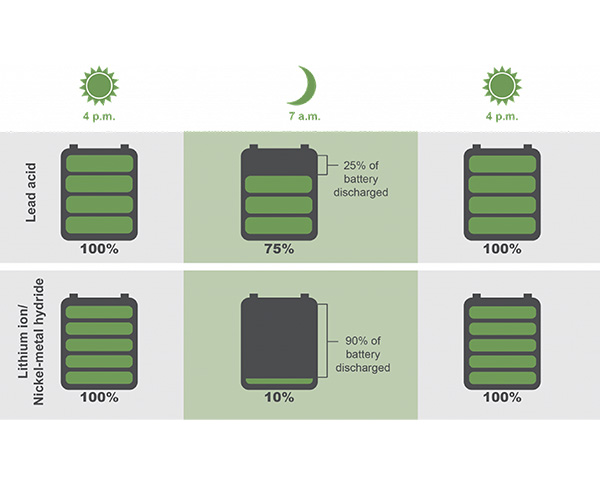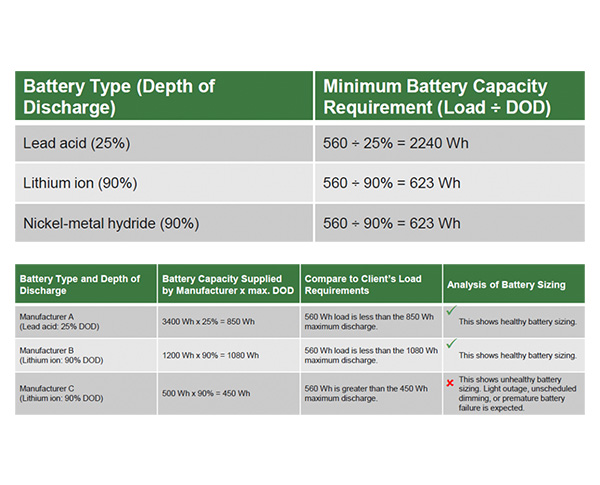Educational January 2020
When it comes to solar lighting, the times you want to use energy are rarely the same as when your panels can produce it. Peak electricity generation typically happens around midday; peak consumption happens after dark. That means that if you want to power an off-grid light after dark, you’re going to need a good battery with the right amount of power capacity.
Unfortunately, solar battery options are notoriously confusing. What size of battery do you need? How long do you need it to last? What applications and conditions is it best suited for?
We’re here to guide you. In this this article—part three in a five-part series—we’ll review some battery basics, cover the pros and cons of different types of batteries, and offer a simple calculation you can do to ensure that your battery is sized for optimal health and longevity.
Want to dig deeper? Check out our Ultimate Solar Lighting Guide, which gives a primer on how solar lighting works, why clients choose solar, and gets into the finer points of product specifications and comparisons.
One of the main issues solar lighting customers face is premature battery death. This can be frustrating and costly—but it’s also largely preventable.
That’s because the issue is not that solar or battery technology is inherently unreliable, but that too often, solar lighting systems are improperly designed or poorly sized, meaning a battery doesn’t have an adequate amount of solar to recharge during the day and/or the lighting load is larger than the battery’s capacity – both result in frequent battery replacements.
A properly designed system takes several variables into account to optimize the battery longevity, including system load, depth of discharge and backup power.
While many kinds of batteries are used for electricity storage, the three main battery types used for solar lighting applications are:
Each type has its own benefits, drawbacks and performance characteristics, and based on your project requirements, there are pros and cons for each. Before we get to that though, we need to understand a couple key concepts: depth of discharge and backup power (we’ll cover the latter in greater detail in another article).

The amount of energy a battery discharges each day is referred to as daily depth of discharge (DOD). If you use half of your battery’s capacity throughout the day, the DOD would be 50%.
Different battery types can safely discharge different amounts—this is commonly referred to as the recommended depth of discharge. Continuously using the battery past its recommended DOD will greatly reduce the battery’s lifespan, also known as cycle life.
For example, a lead-acid battery has a recommended DOD of around 25%. This means that around a quarter of its capacity can be safely used each night before it needs to be recharged—beyond that point, you risk reducing its lifespan. By contrast, a lithium-ion or nickel-metal hydride battery has a recommended DOD of around 90%, meaning you can consume nearly its entire capacity without reducing its lifespan.
Knowing your battery chemistry and DOD is essential to understanding how a manufacturer is sizing your system and determining your battery capacity requirements.
As mentioned above, different batteries are better suited than others to different applications, and a lot of this has to do with where your lighting project is located and what your budget is.
Lead-acid batteries are a tested technology that have been used in off-grid solar systems for decades. Though they have a shallower depth of discharge compared to their lithium-ion counterparts, they come with the added benefit of being able to store more built-in backup power. This can be advantageous for projects located in more northern areas where daily sunlight is not guaranteed. Lead-acid batteries are also the more affordable option.
Lithium ion batteries are much more expensive up front, but they are comparably lightweight (making them easier to install) and have a greater depth of discharge and longer lifespan than lead-acid batteries. They are a good choice for applications where backup power is less of a concern.

Now let’s put this into practice, revisiting our example scenario from part two, the new collector road in Los Angeles, California.
We determined that with a 40-watt fixture running over a 14-hour night, the total system load was 560 watt-hours (Wh). Assuming you have a fully charged battery and perfect weather, what is the minimum capacity for each type of battery? We can figure that out by dividing the total system load by each battery type’s recommended DOD.
If your manufacturer has specified lead-acid batteries for this project, their system will need 2240 watt-hours worth of batteries in order to meet your load requirements. A lithium ion battery-specified system will only need 623 watt-hours worth of batteries. That might seem like a better choice, but remember that with a smaller size comes a higher cost, and you may be able to achieve the same number of watt-hours with more lead-acid batteries for a lesser cost (see our battery type comparison above).
While depth of discharge and minimum required battery capacity are important components of proper solar system design, they are still only part of the picture. They consider how your system will operate under expected conditions, but what about when things takes a turn? To ensure that your system stays operational no matter what the weather, you’ll need to consider backup power, also known as system autonomy. We’ll cover that in our next installment. Check back soon!
Articles in this series:
